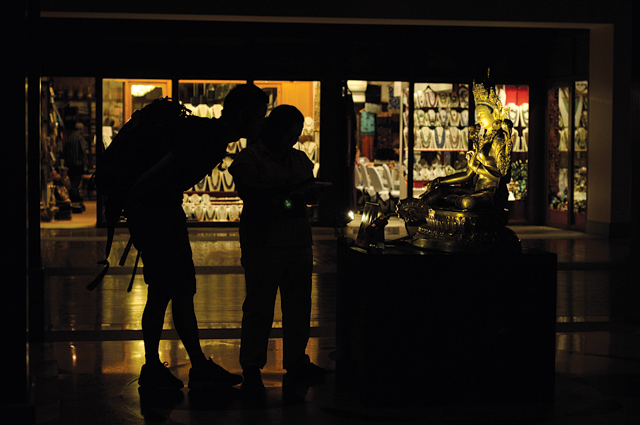The second installment of the Jewels of Newar Art at the Hyatt Regency boasted a collection of majestic pieces that celebrated the potency and opulence of the art of the Newars
An eye for art. Some men have it, some don’t. I’ve always considered myself firmly in the latter. Which is why, as I crossed the beautiful pool of water and entered the imposing gold-plated door at Hyatt’s Court Of Nine Chaityas, I felt a mild trepidation. Here I was, a man with no artistic sensibilities, attending a highly regarded exhibition – the second installment of Bodhisattva Gallery’s Jewels Of Newar Art. I felt lost. The imposing golden Green Tara that greeted me was not helping either. “Ah but there’s always something to learn,” I tried to make myself believe and soldiered on.
Skimming through the court, I was immediately drawn to the chaityas in the middle. Then I realized they weren’t even part of the installation. This was an indication of how appropriate the venue was. The nine paintings and sixteen sculptures that were placed around these chaityas fit right in with the surroundings.
The first non-chaitya to catch my attention was a Paubha painting of Harihariharivahana Lokeshvara by Sundar Sinkhawal. Paubhas, for those not in the know, are traditional Newari artworks that portray religious deities and monuments. The extremely high level of maturity in his work was evident at first glance. Painted with gouache on primed cotton, the majestic illustration was story-based with Lokeshvara riding on the shoulders of the Hindu god Vishnu, who in turn was astride Garuda, who was then supported by a lion. The iconography was typically Newari, the motifs all pointing towards the dominance of Buddhism over Hindu deities. The style in use, I was told by the curator, was trademark Sinkhawal.
On the other side of the gallery was a large image of the Dipankara Buddha, crafted jointly by Saziv and Sujeet Shakya. This mixed medium piece was an oil painting of the enlightened one, accented by a gold metal crown and necklace. The metal and coin medallions ended up giving the entire portrait an appealing sense of depth.

While the paubhas were certainly high quality, it was the copper sculptures that I found most impressive. The statues on display were fashioned using the lost wax process, a form of casting in which molten metal is poured into a mold formed around a wax pattern that has been melted and drained. Gyanendra Shakya’s 12-inch figurine of Vajrayogini was the first one I fell upon. Inspired by the 17th-18th century Vajrayogini Nada-Kechari, the effigy was curvaceous and intricate.
‘Dramatic’ was the word that came to mind when confronted with the image of the goddess standing upon two other deities – Kalarati and Bhairava – while holding a staff blanketed with skulls. Her ruby red necklace contrasted well with the copper exterior.
A little further on was an evocative and detailed sculpture of Yamantaka/Vajrabhairava. At 11-inches, the statue seemed diminutive but molder Rajesh Awale and carver Gahendra Shakya had spared no effort in bringing out the intensity of the buffalo-headed god. The 34-arms of the deity were intricately carved, almost lifelike in detail.
As I left the square, strains of a sarangi began emanating through the venue courtesy of the folk band situated in the corner. Around me were well-known artists and their families making an evening out of the exhibit. I don’t know how much of an eye for artistic beauty and nuance I developed but I surely did come out feeling a bit more informed. And perhaps that’s exactly what great art is meant to do.








